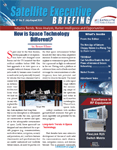C-Band Spectrum Essential to Asia Pacific Region According to a New Study Released at CASBAA Satellite Industry Forum
Singapore, June 17, 2014–CASBAA welcomed issuance of the first authoritative study of the extent to which satellite C-band services provide socio-economic benefits to countries in the Asia-Pacific region. The study found that “C-band is extensively used for communication networks, often of critical importance to these countries’ economy, society or security.”
Paris-based technology consultancy Euroconsult examined the situation on-the-ground in three markets representative of the diverse economies of southern Asia and the Pacific, and found that – in addition to the hundreds of millions of consumers who rely on C-band television streams – the banking and finance, energy production, and government sectors were particularly dependent on satellite networks using C-band spectrum, which is prized for its reliability and scope of coverage.
The markets selected for the study were India (a huge, continental rapidly-industrializing nation), Indonesia (a very populous archipelagic nation) and Papua New Guinea (the largest of the Pacific Island nations).
“C-band communications are perceived in some other parts of the world to be of declining importance,” said CASBAA’s Chief Policy Officer John Medeiros. “But that has never been true in Asia, where conditions are fundamentally different than in North America or Europe, and Euroconsult’s report spells it out in black and white. In particular, C-band communications are part of the bedrock of daily life and economic activity in tropical Asia.”
Key Asian uses of C-band networks described in Euroconsult’s report included:
· All three countries use C-band networks as the lynchpin of their disaster emergency communications, in particular as part of extremely time-sensitive systems being deployed to warn coastal populations of impending tsunamis.
· India has made C-band communications a key part of its security operations, with over 7,000 C-band antennas deployed by security forces to defend the country and keep the peace.
· In Papua New Guinea the reliability of C-band communications is essential to providing essential real-time monitoring of wells and pipelines to guarantee safe and reliable LNG production.
· Indonesia’s financial industry uses C-band communications to service the country’s far-flung regions and improve rural connectivity. 75,000 ATMs use C-band to dispense a daily volume of more than US$400 million, and one Indonesian bank recently announced plans to procure its own satellite “to reach people in all corners of the country in support of the financial inclusion program.” Government is also using C-band to deliver essential e-services around the country, including providing the entire population with biometric identity cards.
· Finally, huge numbers of Asians depend on C-band for their information and entertainment. In the countries studied as well as others in tropical Asia, as many as 30 million individual consumer households are estimated to watch TV through their own C-band dishes. Several hundred million other consumers subscribe to cable or Ku-band satellite television services whose content is delivered by C-band. (Cable connections in Asia are in the neighborhood of 350 million, according to sources cited in the report, and around 2,375 TV channel signals are transmitted on C-band – up enormously from around 950 in 2005.)
The report notes that C-band communications benefit from two physical characteristics that make it so central to Asia’s environment: resistance to “rain fade” and availability of wide beams. “There is simply no substitute that can equal the coverage and the reliability of C-band satellite beams,” said CASBAA CEO Christopher Slaughter. As a result, billions of dollars have been invested in 60 C-band satellites over Asia, providing almost half (47%) of the total satellite capacity used in the region. Euroconsult estimates the annual value of the C-band capacity market in Asia at US$800 million annually.
“Over the next few months, the international community will be making key decisions on spectrum priorities,” said Medeiros. “Asian governments need to sit up and take notice of the huge contribution by satellite C-band communications to their populations and their economies.”
Copies of the full report can be downloaded from www.casbaa.com/CBandAssessment.






